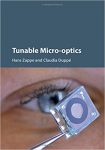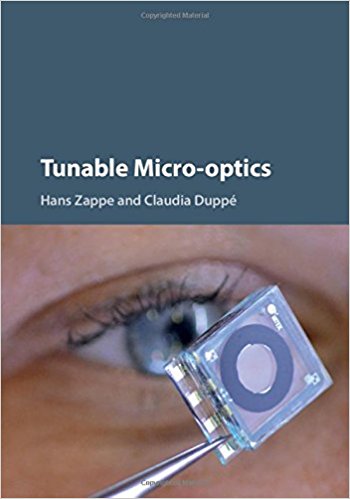 Authors: Hans Zappe and Claudia Duppe
Authors: Hans Zappe and Claudia Duppe
Publisher: Cambridge University Press – 449 pages
Book Review by: Sonu Chandiram
At the outset, we want to clarify the use of the word ‘tunable’ in the title of this book. This word brings into mind the word ‘sound’, but one of the suggested alternative words that can be used is ‘adjustable’.
This book published in 2016 is the first to present a comprehensive survey of state-of-the art research in the dynamic field of tunable (adjustable) micro-optics. It covers a wide range of topics including:
- New imaging systems in optics
- Novel materials
- Activation concepts
Seventy-three specialists in various aspects of optics, mainly from Germany but also from four other countries – Belgium, Japan, Taiwan, and the United States – authored or coauthored the 17 chapters of this unique book on a relatively new and growing field.
They present, among other materials and matters, the following:
- Artificial muscles
- Complete tunable imagers
- Cutting-edge materials
- Devices
- Photonic crystals
- Soft matter
- Subsystems
- Tunable apertures and lenses
We name the chapters below to provide you an overview of what you will find in this book:
- Part I. Introduction
- Tunable Micro-optics
- Tunable Optics in Nature
- Part II. Devices and Materials
- Soft Matter Micro-optics
- Tunable Reflective Optics
- Tunable Liquid Lenses
- Optofluidic Micro-shutters and Micro-irises
- Solid Body Elastomeric Lenses
- Spatially Tunable Polarization Devices
- Aluminum Nitride and Diamond Membranes for Tunable Micro-optics
- Piezoelectrically Actuated Tunable Microlenses
- Part III. Systems and Applications
- Characterization of Micro-optics
- Photonic Crystals
- MEMS Scanners for OCT Applications
- Liquid Crystal Elastomer Micro-optics
- Adaptive Scanning Micro-eye
- Hyperspectral Eye
- Plenoptic Cameras
This book is an essential resource for engineers in industry and academic institutions, and advanced students working on optical systems design. Special contributions include in-depth treatment of micro-optical characterization, scanners, and the use of natural eye models as inspiration for new concepts in advanced optics.
Let us take a close look at what you will find in a typical chapter by browsing the topics discussed in chapter 3 entitled Soft-Matter Micro-Optics authored by Wolfgang Monch
He writes in his Introduction that when you think about optics and soft matter, you typically cannot, at least immediately, think of a connection between the two. The word ‘optics’ brings into mind a solid material – glass – whereas the word ‘liquid’ conjures up an image of something flowing, such as water, from a tap.
But the author points out that in the nineteenth century, Swiss physicist Daniel Colladon used water jets to illustrate the guiding of light. He used colored water in glass vessels to demonstrate the effects of illumination for aesthetic purposes. The optical effects generated by water droplets can be seen for example when a drop of water on printed words make the letters look larger (magnification) or appear curved (deformation).
A broad variety of different materials can be grouped together within the term ‘soft condensed matter’ such as liquids, colloids, polymers, liquid crystals, composites and much biological matter. Some of these materials have been used to develop devices used in optics.
This chapter consists of the following topics beyond the Introduction:
- Soft-Matter Micro-optics Based on Wetting Effects
- Basic Equations
- Actuation Mechanisms
- Liquid lenses
- Systems and Applications
- Soft-Matter Micro-optics Based on Elasticity
- Elasticity Effects
- Elastomer-Membrane Lenses
- Other Developments in Elastomer Optics
- Conclusion and Summary
This is a pioneering work on the new and growing field of micro-optics. Much can be learned – by industry and academic professionals – working in optics.
Authors:
Hans Zappe is the Gisela and Ervin Sick Chair of Micro-optics at the University of Freiburg in Germany, and an internationally recognized teacher and researcher in micro-optics. He has 25 years’ experience working on optical Microsystems, integrated optics, and semiconductor lasers, and has previously authored three textbooks.
Claudia Duppe was Administrative Program Manager of the DFG Priority Program “Active Micro-optics” at the University of Freiburg. She holds a PhD in New Zealand literature and has focused professionally on academic communication and science management. She is presently Head of Communication and Networking at the Catholic University of Applied Sciences in Freiburg, Germany.
It has often been said that a picture is worth a thousand words. Sometimes, a video does the job even better than a picture. Below is a link to a video of a TED talk related to chapter 5, Tunable Liquid Lenses that illustrates how the problem of adjusting vision can be solved:
https://www.google.com/search?ei=Ru3NWu2oKqeX0gLzj7yIAw&q=wikipedia%3A+videos+of+liquid+lenses&oq=wikipedia%3A+videos+of+liquid+lenses&gs_l=psy-ab.12…5357.10961.0.15375.15.15.0.0.0.0.212.1966.0j13j1.14.0….0…1.1.64.psy-ab..1.0.0….0.UZtTmHNPiBY






